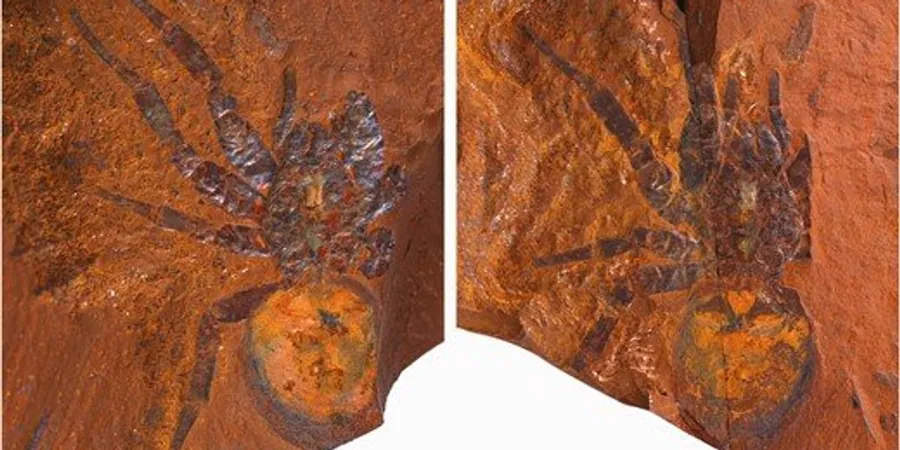
Scientists Uncover 'Giant' Prehistoric Spider Fossil in Australia, Shattering Our Understanding of Evolution!
2024-11-09
Author: Lok
Giant Trapdoor Spider Discovery in Australia
Recent discoveries in Australia have sent shockwaves through the scientific community as researchers have unveiled a fossilized giant trapdoor spider in New South Wales—marking only the fourth specimen of its kind ever found on the continent.
A Colossal Prehistoric Version
If you thought Australia’s notorious spiders were daunting, wait until you see this colossal prehistoric version! The fossil, named Megamonodontium mccluskyi, dates back to the Miocene period, approximately 11 to 16 million years ago, during a time when the area was lush with rainforests, teeming with diverse life forms including vibrant plants, giant cicadas, and wasps.
Environmental Shifts and Historical Significance
Today, this rich historical site is known as McGraths Flat—a stark contrast to its former environment, reflecting the dramatic climate changes Australia has undergone over millions of years. "These discoveries provide a crucial lens into the past and tell us so much about environmental shifts," explains palaeontologist Matthew McCurry from the University of New South Wales and the Australian Museum.
Impressive Size and Anatomical Studies
What makes this find particularly remarkable is the sheer size of Megamonodontium mccluskyi, which is five times larger than its modern relatives. Measuring a whopping 23.31 millimeters—over an inch long—this ancient arachnid prowled the rainforest floors, showcasing the fascinating adaptations these creatures had for hunting.
Linking Ancient and Modern Spiders
Researchers utilized advanced scanning electron microscopy to study the minute details of the spider’s anatomy, including its claws and setae, leading them to confidently link it to the contemporary Monodontium trapdoor spider. “The discovery is significant not only because of its size but also because it provides insight into a lineage that once thrived in wetter environments across mainland Australia—prior to its transition into an arid landscape,” states virologist Michael Frese from the University of Canberra.
Implications for Spider Evolution and Climate Change
The implications of this fossil extend beyond mere curiosity; it sheds light on the evolutionary history of spiders and their reaction to climate change. The fossilized remnant was found within layers of rainforest sediment, suggesting that the region was significantly wetter in the past, a stark contrast to today's conditions. This provides vital clues regarding how current and future climate shifts could continue to reshape Australia's biodiversity.
Significance in Arachnology
Robert Raven, an esteemed arachnologist at the Queensland Museum, noted, “This is not only the largest fossilized spider discovered in Australia but also the first fossil of the Barychelidae family found globally. It’s astounding to consider that there are roughly 300 species of brush-footed trapdoor spiders today, yet they rarely become fossilized due to their hidden lifestyles within burrows.”
A Reminder of Ecosystem Balance
As the scientific community digs deeper into ancient history through this fossil, we are reminded of the intricate balance of our ecosystems and the enduring impact of climate on life forms. The findings were published in the Zoological Journal of the Linnean Society, igniting discussions on the past, present, and future of arachnid evolution as we know it.
Conclusion and Future Discoveries
Stay tuned for more astonishing discoveries that reshape our understanding of nature's timeline!




 Brasil (PT)
Brasil (PT)
 Canada (EN)
Canada (EN)
 Chile (ES)
Chile (ES)
 España (ES)
España (ES)
 France (FR)
France (FR)
 Hong Kong (EN)
Hong Kong (EN)
 Italia (IT)
Italia (IT)
 日本 (JA)
日本 (JA)
 Magyarország (HU)
Magyarország (HU)
 Norge (NO)
Norge (NO)
 Polska (PL)
Polska (PL)
 Schweiz (DE)
Schweiz (DE)
 Singapore (EN)
Singapore (EN)
 Sverige (SV)
Sverige (SV)
 Suomi (FI)
Suomi (FI)
 Türkiye (TR)
Türkiye (TR)